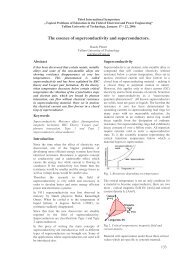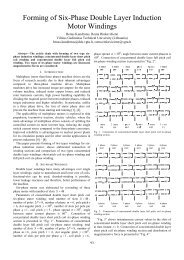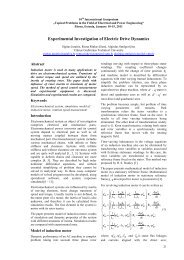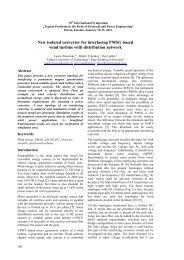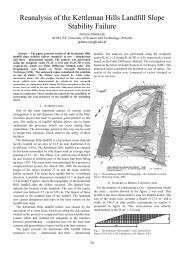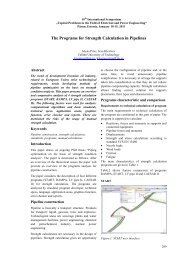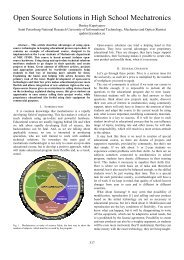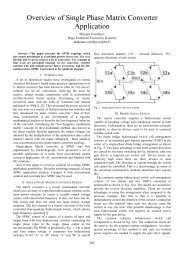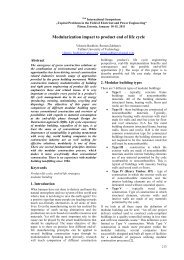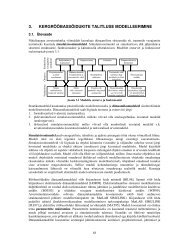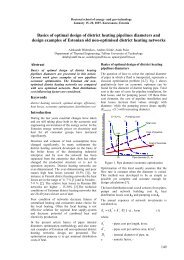An Overview of Electrical Vehicle and Hybrid Electrical Vehicle Drives
An Overview of Electrical Vehicle and Hybrid Electrical Vehicle Drives
An Overview of Electrical Vehicle and Hybrid Electrical Vehicle Drives
Create successful ePaper yourself
Turn your PDF publications into a flip-book with our unique Google optimized e-Paper software.
<strong>An</strong> <strong>Overview</strong> <strong>of</strong> <strong>Electrical</strong> <strong>Vehicle</strong> <strong>and</strong><strong>Hybrid</strong> <strong>Electrical</strong> <strong>Vehicle</strong> <strong>Drives</strong><strong>An</strong>ton RassõlkinTallinn University <strong>of</strong> Technology (Estonia)<strong>An</strong>ton.Rassolkin@ttu.eeAbstract— <strong>An</strong> overview <strong>of</strong> electrical vehicles <strong>and</strong> hybridelectrical vehicles is presented. Main features <strong>of</strong> traction systemare presented with their benefits <strong>and</strong> drawbacks. The tractionsystem architectures, propulsion systems <strong>and</strong> used powerelectronic converters areas are covered. The main areas <strong>of</strong>future researches are squared.I. INTRODUCTIONWorld population reached seven billion people in 2011 <strong>and</strong>the number <strong>of</strong> vehicles in operation surpassed the 1 billionunits already in 2010. According to OICA (InternationalOrganization <strong>of</strong> Motor <strong>Vehicle</strong> Manufacturers) statistic about80 million vehicles were produced in 2011 <strong>and</strong> the number isincreasing each year. With further urbanization,industrialization <strong>and</strong> globalization, the trend <strong>of</strong> rapid increasein the number vehicles worldwide is inevitable. The mainissues due to increasing <strong>of</strong> vehicle number are limited volume<strong>of</strong> oil <strong>and</strong> the emissions from burning oil products. The worldconsumes approximately 85 million barrels <strong>of</strong> oil every daybut there are only 1300 billion barrels <strong>of</strong> proven reserves <strong>of</strong>oil. At the current rate <strong>of</strong> consumption, the world will run out<strong>of</strong> oil in 42 years [1]. The emissions from burning fossil fuelsincrease the carbon dioxide (CO 2 ) in the Earth’satmosphere [1]. Increasing <strong>of</strong> CO 2 is a cause <strong>of</strong> greenhouseeffect <strong>and</strong> climate change. As result in long-termconsequences it will lead to rising sea levels <strong>and</strong> instability <strong>of</strong>ecosystems. Cutting fossil fuel usage <strong>and</strong> reducing carbonemissions are the main goals <strong>of</strong> humanity. Using <strong>of</strong> <strong>Hybrid</strong><strong>Electrical</strong> <strong>Vehicle</strong>s (HEV) instead <strong>of</strong> Internal CombustingEngine <strong>Vehicle</strong> (ICEV) could notably decrease theatmosphere pollution. Effect <strong>of</strong> using <strong>of</strong> <strong>Electrical</strong> <strong>Vehicle</strong>(EV) could be even better.Well-to-wheel studies show that, even if the electricity isgenerated from petroleum, the equivalent kilometres that canbe driven by 1 litre <strong>of</strong> petrol is 46 km in an electric car,compared to 14 km in an ICEV [1]. Moreover, a size <strong>of</strong>petrol-to-electrical transmission is more compact, while witha pure mechanical transmission from engine to wheels a largenumber <strong>of</strong> gears are required <strong>and</strong> with a generator-motortraction system wide range <strong>of</strong> operating speeds are available.Sure, the producing <strong>of</strong> electricity is complicating process <strong>and</strong>not always friendly to environment <strong>and</strong> <strong>of</strong>ten connected withburning <strong>of</strong> fossil fuels as well. In the same way, currentlyused electrical grids have a list <strong>of</strong> disadvantages. But on theother h<strong>and</strong>, today is available quite big range <strong>of</strong> renewableenergy sources <strong>and</strong> energy storage systems that are combinedinto the smart electrical grids. EV’s have many advantages<strong>and</strong> challenges. Nowadays, EV is widely used as publicelectrical transport. It’s difficult to imagine the modernmegalopolis without underground railways or l<strong>and</strong> electricaltransport like tramway car or trolley bus. In that case researchin the field <strong>of</strong> HEVs <strong>and</strong> EVs seems to be very interesting <strong>and</strong>necessary.II. HEV AND EV TOPOLOGIESThere are many different ways to combine internalcombusting engine (ICE) with an electrical machine. Theelectrical machine is designed to h<strong>and</strong>le transient powervariations <strong>and</strong> helps the engine to operate more constantly sothat higher efficiency <strong>and</strong> lower tailpipe emissions can beachieved [6]. The variety <strong>of</strong> electrical machine / combustionengine designs can be differentiated by how the electric <strong>and</strong>combustion portions <strong>of</strong> the power train connect, at what timeseach portion is operation <strong>and</strong> what percent <strong>of</strong> the power isprovided by each hybrid component [7].Nowadays used topologies are presented in this paper.Available nowadays energy storage systems that could beused in HEV <strong>and</strong> EV were presented in previous studies [3]<strong>and</strong> needed to be taken into account during the vehicletopologies analyse.A. Assist HEVThe electric motor is essentially a very large motor whichoperates not only when the engine needs to be turned over,but also when the driver presses the throttle pedal <strong>and</strong>requires extra power [7]. Because <strong>of</strong> the small range <strong>of</strong> theelectric drive assist hybrid could not operate in pure electricalmode, but it can be used as assist motor in wide range <strong>of</strong>controlled torques <strong>and</strong> speeds. As well the part <strong>of</strong> kineticenergy could be converted into electrical energy duringregenerative braking while vehicle decelerates. The size <strong>of</strong>electrical battery used in assist hybrids is reduced that reducethe total weight <strong>of</strong> the vehicle.B. Mild HEVThe mild hybrid has a small electric motor that mostly usedas starter <strong>and</strong> generator sometimes it does operate as tractionmotor as well. Usually, the power rating <strong>of</strong> the electric motormay be in the range <strong>of</strong> about 10% <strong>of</strong> the engine powerrating [8]. Mild hybrid could operate as pure electrical vehicle(the combustion engine is switched <strong>of</strong>f in that mode) only insmall speed range, up to 10 km/h. The design <strong>of</strong> the tractionpart <strong>of</strong> mild hybrid is similar to combustion engine vehicletraction system, because booths are very close.C. Full HEVFull hybrids are type <strong>of</strong> the vehicles that can use pureelectrical traction mode, that notably reduce CO 2 emission.The hybrid-drive concept appears in many forms dependingon the mix <strong>of</strong> energy sources <strong>and</strong> propulsion systems used onthe vehicle [9]. The traction energy could be taken from two76
separate energy sources there are several combination <strong>of</strong>these available.D. Parallel HEVParallel HEV is only hybrid vehicle that can switchbetween two types <strong>of</strong> drives <strong>and</strong> could be used separately orsimultaneously, depends on traction mode. The electric drivealso can be used as a generator to recharge the batteries whenthe engine produces more power than is needed to propel thevehicle [10]. Combustion engine <strong>and</strong> electric drive arecoupled mechanically by special gear construction <strong>and</strong> couldbe unplugged by reswitching <strong>of</strong> a clutch. Parallel hybrid usemostly electrical drive in urban areas, because <strong>of</strong> urb<strong>and</strong>riving particular qualities, fast acceleration/deceleration <strong>and</strong>short-time duty cycles. In highway traction mode, when thevehicle runs with a high constant speed <strong>and</strong> ICE is used.Combustion engine shows its better performance only in asmall working range with high speed <strong>and</strong> torque that meansthe speed variation is unwished. Parallel hybrid couldrecharge its batteries not only during regenerative braking,but also during ICE traction mode. However, ICE is used noton its better performance mode <strong>and</strong> that is one <strong>of</strong> parallelhybrid drawbacks. Double traction system increases the price<strong>of</strong> the vehicle as well.E. Series HEVSeries HEV use only electrical drive for traction. ICE isdecoupled from mechanical transmission <strong>and</strong> used to producekinetic energy for the generator that converts it into electrical.That means traction system requires double energyconversion: mechanical-electrical-mechanical. A weakness <strong>of</strong>a series hybrid system is that series hybrids require separatemotor <strong>and</strong> generator portions which can be combined in someparallel hybrid engines; the combined efficiency <strong>of</strong> the motor<strong>and</strong> generator will be lower than that <strong>of</strong> a conventionaltransmission thereby <strong>of</strong>fsetting the efficiency gains that mightotherwise be realized [7]. Because <strong>of</strong> the high controllabilityperformance <strong>of</strong> electrical motor that topology reduces the size<strong>of</strong> gearbox <strong>and</strong> mechanical transmission. That’s why serieshybrid widely used in heavy industrial vehicles likeexcavators <strong>and</strong> diesel-electrical locomotives also for urbanvehicles that required <strong>of</strong>ten stop duties like buses <strong>and</strong> deliverycars.F. In-Wheel Motor HEVSome variation <strong>of</strong> series hybrids have separate smallelectric in-wheel motors (sometimes called hub motors)installed independently at each wheel. That allows separatelycontrol <strong>of</strong> the power delivery to each wheel, <strong>and</strong> thereforesimplifies traction control <strong>of</strong> the vehicle [7]. Such systemallows regulating the acceleration/deceleration torque valuesindependently for each wheel. Тhe mechanical part could bereduced even more than in series hybrids. It means additionalbatteries can be installed on the free space that has beenoccupied by the transmission, which helps to increase thedriving range per charge [20]. Most conventional electricalmachines (such as ac excited or brushed dc motors) are notsuitable for application in in-wheel motor drive because <strong>of</strong>their poor torque density <strong>and</strong> overload capability [11]. Forthat reason in-wheel hybrids required special designed motorslike axial-flux ironless permanent magnet motors orsynchronous permanent magnet outer rotor motors.G. Series–Parallel HEVSeries–parallel HEV has two couplings mechanical <strong>and</strong>electrical. That allows overcoming <strong>of</strong> the drawbacks <strong>of</strong> boothtechnologies <strong>and</strong> using their benefits with best performance.The main aim <strong>of</strong> such system is the reduction <strong>of</strong> the fuelconsumption [12]. As well, drivability can be optimizedbased on the vehicle’s operating condition [2]. The maindrawback <strong>of</strong> series-parallel hybrid is increased vehicle pricein compare with other hybrids.H. Plug-In <strong>Hybrid</strong> Electric <strong>Vehicle</strong>s (PHEV)The only difference <strong>of</strong> plug-in hybrid from the hybridvehicle is presence <strong>of</strong> the cable that allows connecting vehicleto electrical grid. Depends from the energy flow directionplug-in systems divides could be divided on two parts:vehicle-to-grid (V2G), if the energy flow goes to the gridfrom the vehicle; grid-to-vehicle (G2V) if the batteries arecharged from the grid. G2V allows recharging the batterieswithout using ICE that makes daily used light PHEV moreenvironmentally friendly. The basic concept <strong>of</strong> V2G power isused in electric drive vehicles to provide electric power to thegrid while the vehicle is parked [13]. It means that thebatteries on parked <strong>and</strong> plugged-in vehicle could be rechargedduring the lean hours <strong>and</strong> discharged during the peak hours ifit’s necessary. To allow such bi-directional energy flow (G2V<strong>and</strong> V2G) the charging systems should be specificallydesigned <strong>and</strong> optimized. In that case the vehicle is used as asmart consumer, so-called prosumer (combined producer <strong>and</strong>consumer) <strong>and</strong> can be used as a part <strong>of</strong> smart electrical grid.Connected to the smart grid PHEV could bring new featuresinto the grid like STATCOM, active filter or even portablepower plant [2].I. Fuel Cell Electric <strong>Vehicle</strong> (FCEV)A fuel cell (FC) is a galvanic cell in which the chemicalenergy <strong>of</strong> a fuel is converted directly into electrical energy bymeans <strong>of</strong> electrochemical processes [14]. There are sometanks required to store the fuel, usually hydrogen. It makesthe FCEV more similar to series hybrid but with a less energyconversion stages. The main benefits <strong>of</strong> FC are – zeroemission, as the sole product <strong>of</strong> reaction is water; highelectric efficiency <strong>of</strong> single device up to 60 %; very simpleconstruction. The mainly drawback <strong>of</strong> a fuel cell for today isits high price <strong>and</strong> limited technologies [3]. <strong>Vehicle</strong>s poweredsolely by fuel cells have some other drawbacks, such as aheavy <strong>and</strong> bulky power unit caused by the low power density<strong>of</strong> the fuel cell system, long start-up time, <strong>and</strong> slow powerresponse [14]. To overcome this drawbacks some hybridsolution are presented, where the FCEV are combined withsome other vehicle technologies [15]-[17].J. All <strong>Electrical</strong> <strong>Vehicle</strong>s (EV)EV use chemical battery as a primary energy storage <strong>and</strong>only electric motor for traction. It means that they have zerotailpipe emission <strong>and</strong> more friendly to environment than othervehicles.The EV has many advantages over the conventional ICEV,such as zero emissions, high efficiency, independence from77
fossil fuels, <strong>and</strong> quiet <strong>and</strong> smooth operation [8]. Usually EVsimplified mechanical motor to wheel transmission that issimilar to series hybrid <strong>and</strong> in-wheel series hybrid vehicles.The design <strong>and</strong> parameters <strong>of</strong> the traction system <strong>of</strong> EVdepends mostly on speed-torque <strong>and</strong> speed-powercharacteristics.All <strong>of</strong> the major automotive manufacturers have productionEVs, many <strong>of</strong> which are available for sale or lease to thegeneral public [5]. While EV is novel technology a lot <strong>of</strong>challenges on its development <strong>and</strong> research areas exist. Newst<strong>and</strong>ards <strong>and</strong> requirements should be prepared. Moreover,public recharging infrastructure is required <strong>and</strong> usednowadays, electrical grids need to be renewed or rebuilt towithst<strong>and</strong> the increasing load. Due to European Unionderictives the governments support the idea <strong>of</strong> HEV <strong>and</strong> EVwith taxes braking <strong>and</strong> other benefits for HEV/EV owners.Though, it seems that the main problem is the driver habits onvehicle use <strong>and</strong> refuelling.III. ELECTRIC MOTORS FOR HEV AND EV PROPULSIONElectric motor has relative benefits <strong>and</strong> drawbacks incompare with traditional ICE. Sure electrical motor is moreefficient <strong>and</strong> has a zero emission. A major advantage <strong>of</strong>electric motor is that torque generation is very quick <strong>and</strong>accurate [4]. That makes EV <strong>and</strong> HEV more controllable <strong>and</strong>manoeuvrable in urban areas. The main drawbacks areelectrical energy sources that are usually short-term storages.There are several types <strong>of</strong> direct current (DC) <strong>and</strong>alternating current (AC) electric motors that can be used astraction motors in HEVs <strong>and</strong> EVs drives.A. DC MotorsThe DC motors were used in last century in electricaltransportation due to their developed status <strong>and</strong> suppleness <strong>of</strong>speed control. Speed-torque diagram <strong>of</strong> the series excite DCmotor is very close to load speed-torque diagram <strong>of</strong> thevehicle that’s why it was widely used in public transport area:tramway cars, trolleybuses, electric trains <strong>and</strong> diesel-electricallocomotives. A number <strong>of</strong> prototype EVs in the 1980s <strong>and</strong>prior were built based on DC series motors as well. However,the size <strong>and</strong> maintenance requirements <strong>of</strong> DC motors aremaking their use obsolete, not just in the automotive industry,but in all motor drive applications [5].The main drawbacks <strong>of</strong> DC motor is a collector brushedthat are required to change the direction <strong>of</strong> the current insidethe rotating part <strong>of</strong> the motor (armature). A result <strong>of</strong> highfriction between brush-contacts <strong>and</strong> collector: high frictionlosses, increasing <strong>of</strong> the temperature <strong>of</strong> the machine, lowreliability, decreasing <strong>of</strong> the lifecycle <strong>and</strong> low efficiency.B. Permanent Magnet Motors (PM Motor)PM DC motor is a brushed DC motor with an independentexcited magnet. Because <strong>of</strong> the limited technologies <strong>of</strong> PMtheir power range is small <strong>and</strong> the speed-torque diagram isclose to parallel excited DC motor. All these drawbacks makePM DC motor not suitable for high power tractionapplications.PM AC motor also known as brushless direct current motor(BLDC), is a three phase windings <strong>and</strong> permanent magnetexcite rotor. For EV <strong>and</strong> HEV applications, motor size isrelatively large compared to the other smaller powerapplications <strong>of</strong> PM motors, which amplifies the costproblem [5]. However, the PM AC motors could be used inassist <strong>and</strong> mild hybrids. The benefit <strong>of</strong> this motor is thatcurrents do not need to be induced in the rotor (like ininduction motor), making them somewhat more efficient <strong>and</strong>giving slightly greater specific power in the same time thedrawback is that it is costlier due to the presence <strong>of</strong> PM [7].C. Switched Reluctance Motors (SRM)SRM is also known as doubly salient machine, has a simpleconstruction <strong>and</strong> excellent fault tolerance characteristics. Thestator <strong>and</strong> the rotor <strong>of</strong> the SRM are made <strong>of</strong> irons which aremagnetized by the current through the stator winding. Thesemotors have no windings, magnets, or cages on the rotor,which helps to increase the torque <strong>and</strong> inertia rating. Themotor speed-torque characteristics are an excellent matchwith the road load characteristics, <strong>and</strong> performance <strong>of</strong>switched reluctance motors for EV/HEV applications havebeen found to be excellent [5].The main drawback <strong>of</strong> SRM is that the timing <strong>of</strong> theturning on <strong>and</strong> <strong>of</strong>f <strong>of</strong> the stator currents must be much morecarefully controlled [7], the more complex control device isrequired. The main challenges <strong>of</strong> switched reluctance motorsare acoustic noise <strong>and</strong> torque ripple.D. Induction MotorsQuite mature technology <strong>of</strong> AC induction motor got a harddevelopment push in last 30 years together with powerelectronics progress. Field-oriented control (FOC) <strong>of</strong>induction motor can decouple its torque control from filedcontrol. This allows the motor to behave in the same manneras a separately excited DC motor [18].Because <strong>of</strong> low stability <strong>and</strong> overheating on low speed,induction motors mostly found an application in high speedvehicles, otherwise some additional mechanical transmissionrequired for speed reduction. Moreover, the efficiency <strong>of</strong> theinduction motor in no-load or light-load operation modes isvery small ca 20..30%, but it increases gradually with therated load <strong>and</strong> reaches ca 75..92% [19]. The main benefits <strong>of</strong>induction motor are high reliability <strong>and</strong> low manufacturingcost.E. Synchronous Permanent Magnet Outer Rotor (In-Wheel)MotorsUsually as in-wheel motor the permanent magnetsynchronous machine (PMSM) is used, it has high torquedensity, excellent efficiency <strong>and</strong> overload capability [21].However, there may be risks <strong>of</strong> demagnetization <strong>and</strong>mechanical damage <strong>of</strong> the rotor’s magnets in extreme drivingconditions [22]. The assembly configuration <strong>of</strong> in-wheelmotor system consists usually not only <strong>of</strong> the motor itself, butalso from reduction gear, mechanical brake <strong>and</strong> wheel.IV. POWER ELECTRONICS USED IN HEV AND EVPower electronics are required to provide the electricalenergy conversion between electrical parts <strong>of</strong> the HEV <strong>and</strong>EV drive. The inverters required to provide connectionbetween AC traction motors <strong>and</strong> the batteries. Rectifiers areused in case <strong>of</strong> applying AC generators as a kinetic-toelectricalenergy converter. DC/DC converters equal the DClink voltage from all energy sources, if more than one is used.78
Special attention should be pointed on the charging systems,while they have a specific requirements <strong>and</strong> st<strong>and</strong>ards.A. InvertersWhile the most <strong>of</strong> energy storage devices are voltagesources, the voltage source inverter (VSI) got the mostcommon in HEV <strong>and</strong> EV applications, but it presentsdifficulty hurdles for the automakers to address the importantissues on system cost, weight, volume, <strong>and</strong> reliability [23].VSI is used to control the speed <strong>of</strong> induction motors <strong>and</strong> PMAC motors. The switches are usually IGBTs for high voltage,high-power hybrid configurations or MOSFETs for lowvoltage designs [2]. Voltage surges caused by rapid voltagetransitions, made by pulse-width modulation (PWM) controltechnique, can cause motor insulation degradation, bearingfailure due to the resulted shaft leakage current, <strong>and</strong>unacceptable electromagnetic interference effects upon thecontrol circuits, as well as acoustic noises in the motor [23].The current source inverter (CSI) uses an inductor forenergy boosting in distinction from VSI that uses capacitor. Ithas several inherent advantages that includes its voltageboosting capabilities, its natural shoot-through <strong>and</strong> shortcircuitprotection capability, <strong>and</strong> a sinusoidal output voltagedue to the effect <strong>of</strong> the output ac filter capacitors, which aremuch smaller than the VSI’s dc capacitor [23].B. RectifiersIn series HEV <strong>and</strong> series-parallel HEV a synchronousgenerator is frequently used to convert mechanical energyproduced by ICE into electrical one. Rectifiers are required toconvert output AC <strong>of</strong> synchronous generator into DC forbattery. There are four common rectifier circuits in seriesHEV: uncontrolled full-bridge diode rectifier, controlled fullbridgethyristor rectifier, uncontrolled full-bridge dioderectifier with dc/dc boost converter <strong>and</strong> PWM voltage-sourcecurrent controlled rectifier [24]. Uncontrolled rectifiers do notallow the bidirectional energy flow that means samegenerators could not be used as starter machine to s<strong>of</strong>t ICEstart.In regenerative braking mode the motor is controlled toachieve stored in the rotating part <strong>of</strong> traction motor kineticenergy, in that case the VSI, that controls the speed <strong>of</strong> the ACmotor, is operated as a PWM rectifier.C. DC/DC ConvertersThe typical application <strong>of</strong> a buck converter in a HEV <strong>and</strong>EV is to step down the high voltage (HV) battery voltage(typically 200 – 400 V) to charge the auxiliary battery(14 V) [2]. With such high step-down voltage rate the dutycycle <strong>of</strong> the buck converter is small as well that affects thedesign <strong>of</strong> the inductor, capacitor, current ripple <strong>and</strong> voltageripple. Moreover, control <strong>and</strong> regulation <strong>of</strong> the buck converteroutput voltage becomes more difficult.Boost converter or non-isolated bidirectional DC/DCconverter is used to step up the HV battery up to HV DC bus.The best operating voltage for VSI that controls tractionmotor is around 600 V. As well that converter allows thebackward energy flow, from the DC link back to batteryduring the regenerative braking.Some application are required: a non-galvanic isolationbetween battery <strong>and</strong> DC link. In that case the best solution isisolated bidirectional DC–DC converter with a highfrequency AC link.D. Charging Systems for PHEV <strong>and</strong> EVThe charging system <strong>of</strong> the PHEVs <strong>and</strong> EVs is one <strong>of</strong> themost important parts <strong>of</strong> the whole system. Charging current,speed <strong>and</strong> efficiency are the main topics that need to bediscussed <strong>and</strong> st<strong>and</strong>ardized. Available today charging systemswith a charging time <strong>and</strong> energy needs are presented in Table1. There is couple <strong>of</strong> charging system topologies usednowadays.Typical on-board chargers limit the power because <strong>of</strong>weight, space, <strong>and</strong> cost constraints <strong>and</strong> are dedicated tocharge the battery for a long period <strong>of</strong> time; an <strong>of</strong>f-boardbattery charger is less constrained by size <strong>and</strong> weight [25].Uncontrollable charging systems are based on diodes <strong>and</strong>mostly bridges schemes cascade with DC/DC converters areused. Diode rectifier bridges have the following drawbacks:the input current harmonic content is high <strong>and</strong> absorbsreactive power from the grid [27]. The power factor could beimproved by using the controllable PWM rectifiers. Moreover,PWM rectifier has sinusoidal grid current, low THD <strong>and</strong>allows bidirectional energy flow (booth G2V <strong>and</strong> V2Gworking modes are possible).CharginglevelChargingtimeTABLE 1EV AND HEV CHARGING SYSTEMSChargerlocationPowersupplyVoltageMaxcurrentFast1-2 h0,3-0,5 h0,3-0,5 h3phLow 6-8 h 3,3 kW 230 V 16 A1ph3-4 h Onboard10 kW 400 V 167 kW 230 V 32 APrimary 2-3 h AOffboardDC 50 kW24 kW 400 V 32 A43 kW 400 V 63 A400 -500 V100 -125 AThere are several drawbacks <strong>of</strong> plug-in charging systems:the cable <strong>and</strong> connector typically delivers 2-3 times morepower than st<strong>and</strong>ard plugs at home <strong>and</strong> this increases risk <strong>of</strong>electrical shock especially in wet environments; the long wireposes a trip hazard <strong>and</strong> gives to poor aesthetics for suchsystems; in harsh climates that commonly have snow <strong>and</strong> ice,the plug-in charge point may become frozen onto thevehicle [27]. To overcome this drawbacks <strong>and</strong> inexistence <strong>of</strong>physical contact between the source <strong>and</strong> the load wirelessinductive charging systems could be used. The main benefits<strong>of</strong> wireless charging systems are: the galvanic isolationrequires less maintenance, high output power <strong>and</strong> possibleusage in harsh environments (that is important for northregions as Estonia). The main drawbacks that can be pointedout are: resonant circuits hard to tune, electromagneticinterference, magnetic field does not penetrate metals (if thereis any metallic object in the middle <strong>of</strong> the magneticconnection the losses increase <strong>and</strong> the system may not work),magnetic radiation [28].V. CONCLUSIONSThe HEV <strong>and</strong> EV technology, including system, electricpropulsion, power electronics, <strong>and</strong> charging systems, has79
een reviewed. Together with previous studies [3] there aresome drawbacks <strong>of</strong> today’s HEV <strong>and</strong> EV drives what couldbe detected. The capacity <strong>of</strong> energy storage systems needs tobe extended in that case improving <strong>of</strong> total drive efficiency isvery important. One <strong>of</strong> the possible solutions is to jointogether different energy storage systems <strong>and</strong> advancedpower electronic schemes are required. Similarly some newpower electronic solutions are required for improving thecharging systems <strong>of</strong> future vehicles, to make charging <strong>of</strong> EVmore costumers friendly. There is no exactly solution forpropulsion system for HEV <strong>and</strong> EV that means electricalmotors <strong>and</strong> their control methods need to be studied morecarefully.There are a quantity <strong>of</strong> HEVs <strong>and</strong> EVs already available onthe market. However, an on-road test there is not alwayspossible to test each subsystem separately. In that case the testbenches <strong>of</strong> some st<strong>and</strong>ard parts <strong>of</strong> the vehicles seem as a goodsolution to concentrate on improving <strong>of</strong> the whole system.ACKNOWLEDGMENTPublication <strong>of</strong> this paper has been supported by EuropeanSocial Fund (project “Doctoral School <strong>of</strong> Energy <strong>and</strong>Geotechnology II”).REFERENCES[1] Nick A. Owen, Oliver R. Inderwildi, David A. King, "The status <strong>of</strong>conventional world oil reserves – hype or cause for concern?" EnergyPolicy, vol. 38, no. 8, pp. 4743–4749, August 2010.[2] Chris Mi, M. Abul Masrur, David Wenzhong Gao, “<strong>Hybrid</strong> Electric<strong>Vehicle</strong>s: Principles <strong>and</strong> Applications with Practical Perspectives” , 1sted., Publication A John Wiley & Sons, Ed. United Kingdom: A JohnWiley & Sons, Ltd., 2011[3] <strong>An</strong>ton Rassõlkin <strong>and</strong> Hardi Hõimoja, “Switching Locomotive as a Part<strong>of</strong> Smart <strong>Electrical</strong> Grid”, 8th Power Plant <strong>and</strong> Power System ControlConference, Toulouse, France, 2-5 September 2012[4] Hori, Y.; , "Future vehicle driven by electricity <strong>and</strong> control-research onfour wheel motored "UOT Electric March II"," Advanced MotionControl, 2002. 7th International Workshop on , vol., no., pp. 1- 14,2002[5] Iqbal Husain, “Electric <strong>and</strong> <strong>Hybrid</strong> <strong>Vehicle</strong>: Design Fundamentals”,CRC PRESS Boca Raton London New York Washington, D.C, 2005[6] F. Magnussen, “On design <strong>and</strong> analysis <strong>of</strong> synchronous permanentmagnet for field – weakening operation,” Ph.D. thesis, Royal Institute<strong>of</strong> Tech., Sweden, 2004.[7] Momoh, O.D.; Omoigui, M.O.; , "<strong>An</strong> overview <strong>of</strong> hybrid electricvehicle technology," <strong>Vehicle</strong> Power <strong>and</strong> Propulsion Conference, 2009.VPPC '09. IEEE , vol., no., pp.1286-1292, 7-10 Sept. 2009[8] Mehrdad Ehsani, Yimin Gao, Ali Emadi, „Modern Electric, <strong>Hybrid</strong>Electric <strong>and</strong> Fuel Cell <strong>Vehicle</strong>s: Fundamentals, Theory <strong>and</strong> Design“ -Taylor & Francis, 2009 - 656 pages[9] Ron Hodkinson <strong>and</strong> John Fenton “Lightweight Electric/<strong>Hybrid</strong> <strong>Vehicle</strong>Design” Butterworth-Heinemann Linacre House, Jordan Hill, OxfordOX2 8DP 225 Wildwood Avenue, Woburn, MA 01801-2,ISBN 0 7506 5092 3, 2001[10] A.F. Burke, “<strong>Hybrid</strong>/electric vehicle design operation <strong>and</strong> evaluation,”Society <strong>of</strong> Automotive Engineering paper 920447, 1992.[11] Caricchi, F.; Crescimbini, F.; Mezzetti, F.; Santini, E.; , "Multistageaxial-flux PM machine for wheel direct drive," Industry Applications,IEEE Transactions on , vol.32, no.4, pp.882-888, Jul/Aug 1996[12] Grammatico, S.; Balluchi, A.; Cosoli, E.; , "A series-parallel hybridelectric powertrain for industrial vehicles," <strong>Vehicle</strong> Power <strong>and</strong>Propulsion Conference (VPPC), 2010 IEEE , vol., no., pp.1-6, 1-3 Sept.2010[13] Verma, A.K.; Singh, B.; Shahani, D.T.; , "Grid to vehicle <strong>and</strong> vehicle togrid energy transfer using single-phase bidirectional AC-DC converter<strong>and</strong> bidirectional DC-DC converter," Energy, Automation, <strong>and</strong> Signal(ICEAS), 2011 International Conference on , vol., no., pp.1-5, 28-30Dec. 2011[14] Mehrdad Ehsani; Yimin Gao; Sebastien E. Gay; Ali Emadi; , “ModernElectric, <strong>Hybrid</strong> Electric, <strong>and</strong> Fuel Cell <strong>Vehicle</strong>s : Fundamentals,Theory, <strong>and</strong> Design, Second Edition (Power Electronics <strong>and</strong>Applications Series)”, CRC Press; 1 edition, December 20, 2004[15] Gao, Y.; Ehsani, M.; , "Systematic design <strong>of</strong> fuel cell powered hybridvehicle drive train ," Electric Machines <strong>and</strong> <strong>Drives</strong> Conference, 2001.IEMDC 2001. IEEE International , vol., no., pp.604-611, 2001[16] Schaltz, E.; Khaligh, A.; Rasmussen, P.O.; , "Influence <strong>of</strong>Battery/Ultracapacitor Energy-Storage Sizing on Battery Lifetime in aFuel Cell <strong>Hybrid</strong> Electric <strong>Vehicle</strong>," Vehicular Technology, IEEETransactions on , vol.58, no.8, pp.3882-3891, Oct. 2009[17] Bernard, J.; Delprat, S.; Buchi, F.N.; Guerra, T.M.; , "Fuel-Cell <strong>Hybrid</strong>Powertrain: Toward Minimization <strong>of</strong> Hydrogen Consumption,"Vehicular Technology, IEEE Transactions on , vol.58, no.7, pp.3168-3176, Sept. 2009[18] Ehsani, M.; Yimin Gao; Gay, S.; , "Characterization <strong>of</strong> electric motordrives for traction applications," Industrial Electronics Society, 2003.IECON '03. The 29th <strong>An</strong>nual Conference <strong>of</strong> the IEEE , vol.1, no., pp.891- 896 vol.1, 2-6 Nov. 2003[19] Wang Wei; Wang Qingnian; Yu Yuanbin; Zeng Xiaohua; Zou Naiwei; ,"Study on the Operation Region <strong>of</strong> Induction Traction Motor forElectric <strong>Vehicle</strong>," Measuring Technology <strong>and</strong> MechatronicsAutomation, 2009. ICMTMA '09. International Conference on , vol.2,no., pp.699-703, 11-12 April 2009[20] Byeong-Hwa Lee; Sung-Il Kim; Jeong-Jong Lee; Jung-Pyo Hong;Chang-Soo Park; , "Design <strong>of</strong> an interior permanent magnetsynchronous in-wheel for electric vehicles," <strong>Electrical</strong> Machines <strong>and</strong>Systems (ICEMS), 2010 International Conference on , vol., no.,pp.1226-1229, 10-13 Oct. 2010[21] Fei, W.; Luk, P.; Jinupun, K.; , "A new axial flux permanent magnetSegmented-Armature-Torus machine for in-wheel direct driveapplications," Power Electronics Specialists Conference, 2008. PESC2008. IEEE , vol., no., pp.2197-2202, 15-19 June 2008[22] Fei, W.; Luk, P.C.K.; Shen, J.; Wang, Y.; , "A novel outer-rotorpermanent-magnet flux-switching machine for urban electric vehiclepropulsion," Power Electronics Systems <strong>and</strong> Applications, 2009. PESA2009. 3rd International Conference on , vol., no., pp.1-6, 20-22 May2009[23] Zhiqiao Wu; Gui-Jia Su; , "High-performance permanent magnetmachine drive for electric vehicle applications using a current sourceinverter," Industrial Electronics, 2008. IECON 2008. 34th <strong>An</strong>nualConference <strong>of</strong> IEEE , vol., no., pp.2812-2817, 10-13 Nov. 2008[24] Al-Busaidi, A.; Pickert, V.; , "Comparative Study <strong>of</strong> Rectifier Circuitsfor Series <strong>Hybrid</strong> Electric <strong>Vehicle</strong>s," <strong>Hybrid</strong> <strong>and</strong> Eco-Friendly <strong>Vehicle</strong>Conference, 2008. IET HEVC 2008 , vol., no., pp.1-6, 8-9 Dec. 2008[25] Yilmaz, M.; Krein, P.T.; , "Review <strong>of</strong> charging power levels <strong>and</strong>infrastructure for plug-in electric <strong>and</strong> hybrid vehicles," Electric <strong>Vehicle</strong>Conference (IEVC), 2012 IEEE International , vol., no., pp.1-8, 4-8March 2012[26] Lei Shi; Haiping Xu; Dongxu Li; Zengquan Yuan; , "A novel highpower factor PWM rectifier inverter for electric vehicle chargingstation," <strong>Electrical</strong> Machines <strong>and</strong> Systems (ICEMS), 2011 InternationalConference on , vol., no., pp.1-6, 20-23 Aug. 2011[27] Wu, H.H.; Gilchrist, A.; Sealy, K.; Israelsen, P.; Muhs, J.; , "A reviewon inductive charging for electric vehicles," Electric Machines &<strong>Drives</strong> Conference (IEMDC), 2011 IEEE International , vol., no.,pp.143-147, 15-18 May 2011[28] Neves, A.; Sousa, D.M.; Roque, A.; Terras, J.M.; , "<strong>An</strong>alysis <strong>of</strong> aninductive charging system for a commercial electric vehicle," PowerElectronics <strong>and</strong> Applications (EPE 2011), Proceedings <strong>of</strong> the 2011-14thEuropean Conference on , vol., no., pp.1-10, Aug. 30 2011-Sept. 1 201180



